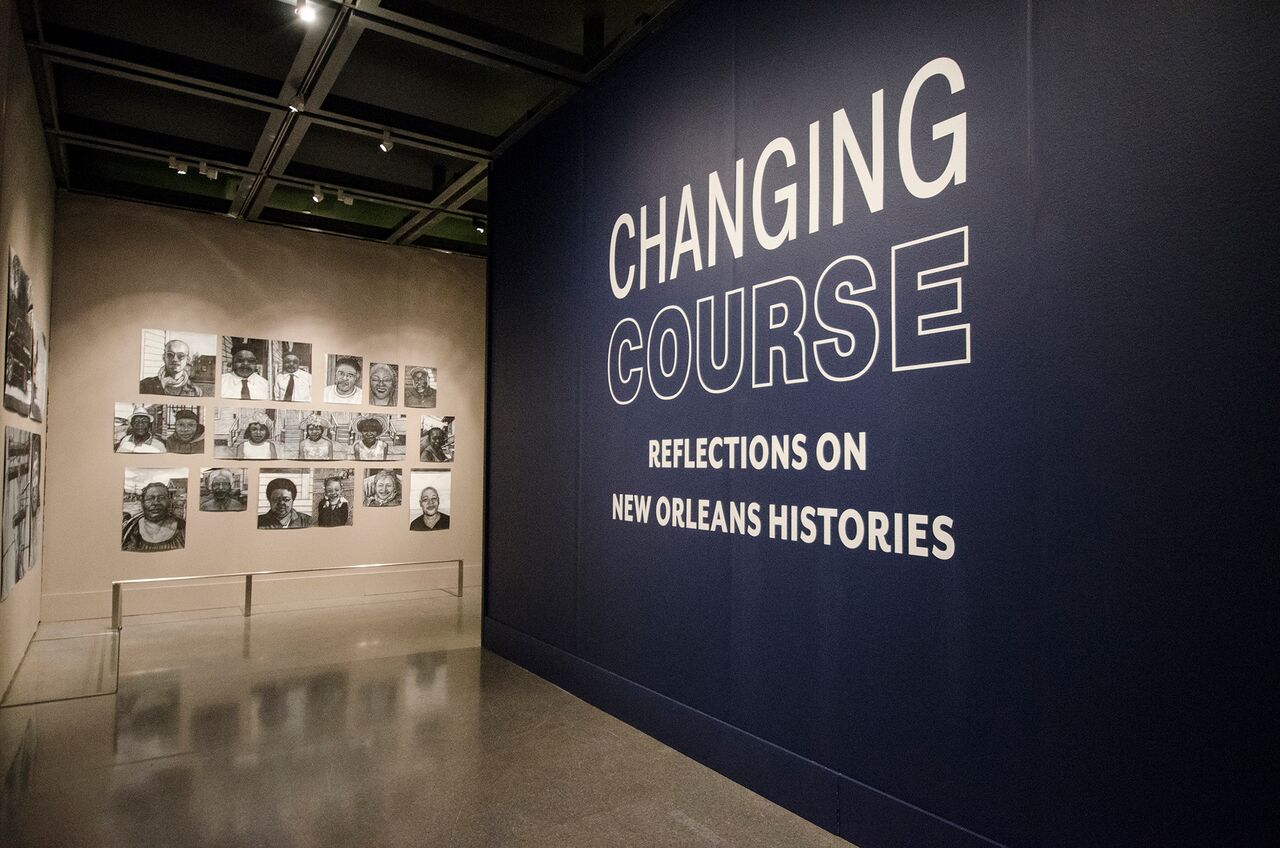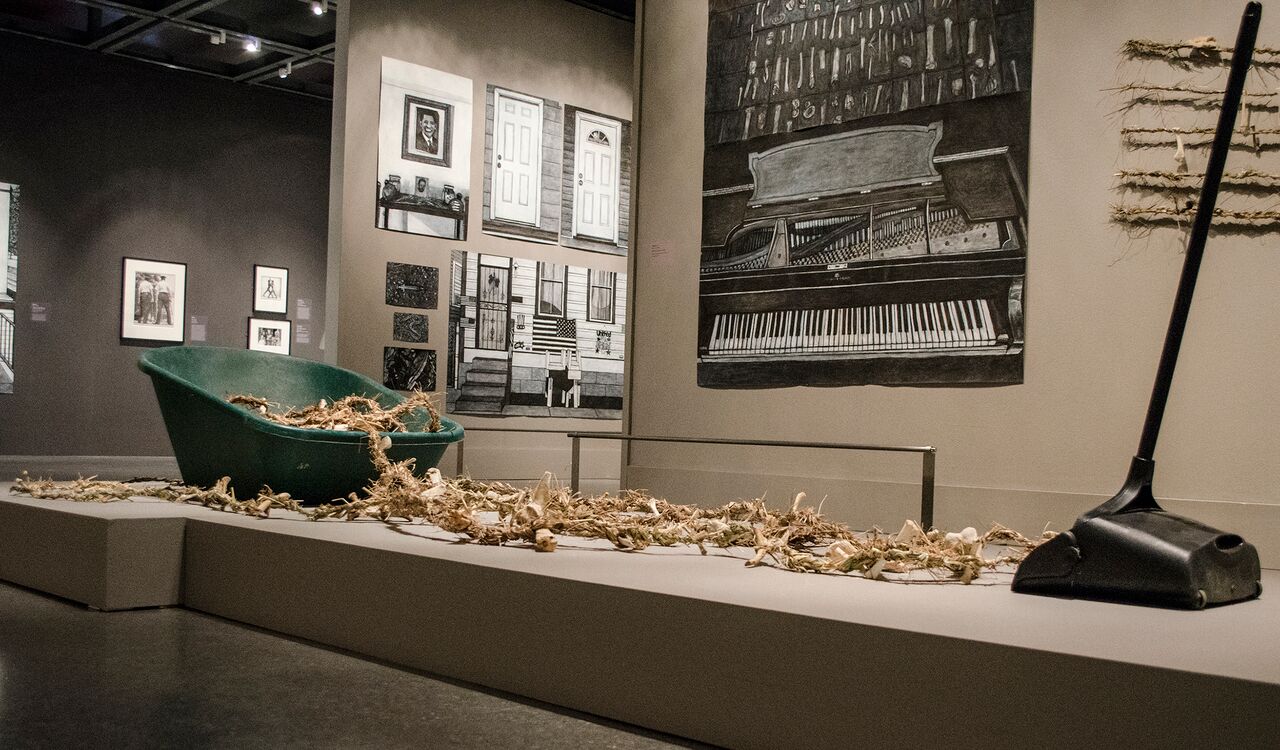
Work by Willie Birch from the exhibit “Changing Course: Reflections on New Orleans Histories.” (Photos by: Carolyn Somers)
To mark New Orleans’ tricentennial, NOMA is providing an immersive look into the city’s past through the lens of some of its more marginalized or forgotten populations.
Changing Course: Reflections on New Orleans Histories brings together a group of seven contemporary art projects where the artists find various ways to remember previous generations, to assert themselves politically, to express a sense of identity, or to engage with episodes in the society’s past that are often overlooked, says Allison Young, Andrew W. Mellon Foundation Fellow for Modern and Contemporary Art at NOMA.
The exhibition opens with local photographer L. Kasimu Harris’ project in the museum’s great hall, a series of photos called “War on the Benighted,” where he creates what he calls a constructed reality, says Young. The series shows young African-American students in various scenes in which they are breaking into their own schools and teaching themselves about histories that are often not taught in the public school system.
Local print maker Katrina Andry’s “Diverge Divest Deny (repeat)” uses large-scale woodblock prints to consider the impact that past infrastructure projects, such as the construction of I-10, had on historically African American neighborhoods in the city. Willie Birch’s new works look at African-American history in the city through roots and bones, while also speaking to a current project of his, an art-centered community space in the Seventh Ward of New Orleans. And rounding out the new work is a series of photographs from the Everyday Project, a community-based education initiative that invites perspectives from New Orleanians participating in a photography workshop.
Other installations are part of NOMA’s permanent collection. Skylar Fein’s “Remember the Upstairs Lounge,” which debuted in 2008 during Prospect 1, is a multimedia installation that pays homage to the 32 victims of the 1973 arson fire at the Upstairs Lounge, a gay bar in the French Quarter. With its mixture of neon signs, video, newspaper accounts and photos, the installation speaks to themes around the construction of history and whose histories and perspectives are presented in institutions.
Also part of the permanent collection is Leslie Dill’s installation “Hell Hell Hell/Heaven Heaven Heaven, Encountering Sister Gertrude Morgan and Revelation.” Dill, a New York based artist interested in the relationship of writing to art – as well as to gender and faith and spirituality – combines images and text culled from Morgan’s art to create a layered multi-media installation that pays homage to the life and work of the prominent painter, preacher, and missionary active in the French Quarter and the Lower Ninth Ward during the 20th century, Young says.

Work by Willie Birch from the exhibit “Changing Course: Reflecting on New Orleans Histories.” (Photos by: Carolyn Somers)
Finally, a video from the permanent collection by the Propeller Group titled “The Living Need Light, the Dead Need Music” thinks through connections between Vietnamese culture in New Orleans in the context of their diaspora to Southeast Louisiana after the war.
Changing Course isn’t just a look back, Young says, it’s also “an opportunity for us to learn about the present day experience of the city, and how we live in the legacies of these histories through understanding them better. That drives us to create a better future that, in many cases, these artists see as being more equitable and more holistic in representation and opportunity.”
Changing Course runs until September 16. Check out www.noma.org for more information on the exhibit as well as on several small pop-up lectures featuring the perspectives of artists as well as other community partners.
NOMA is also offering a community night on Friday, September 7 in conjunction with the exhibit featuring a roundtable about the Everyday New Orleans Project, including some of the photographers who were involved.
 NOLAbeings Multimedia artist Claire Bangser created NOLAbeings as a portrait-based story project that marries...
NOLAbeings Multimedia artist Claire Bangser created NOLAbeings as a portrait-based story project that marries...  Voodoo in New Orleans: Reviving history: New Orleans fortune telling This article takes a deep dive into the history of Voodoo in New Orleans, its hybridization with Catholicism, and its present-day place in the city's culture. The author visits fortune-tellers in the French Quarter, using their guidance as a tool for introspection rather than a deterministic predictor of the future. Through her experiences in New Orleans, the author feels a mystical connection to both the past and the future.
Voodoo in New Orleans: Reviving history: New Orleans fortune telling This article takes a deep dive into the history of Voodoo in New Orleans, its hybridization with Catholicism, and its present-day place in the city's culture. The author visits fortune-tellers in the French Quarter, using their guidance as a tool for introspection rather than a deterministic predictor of the future. Through her experiences in New Orleans, the author feels a mystical connection to both the past and the future. 